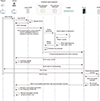1. Greenhalgh T, Hinder S, Stramer K, Bratan T, Russell J. Adoption, non-adoption, and abandonment of a personal electronic health record: case study of HealthSpace. BMJ. 2010; 341:c5814.

2. Pylypchuk Y, Johnson C, Henry J, Ciricean D. Variation in Interoperability among US non-federal acute care hospitals in 2017. ONC Data Brief. 2018; (42):1–15.
5. van der Linden H, Kalra D, Hasman A, Talmon J. Interorganizational future proof EHR systems: a review of the security and privacy related issues. Int J Med Inform. 2009; 78(3):141–160.

7. Walsh T, Miaoulis W. Privacy and security audits of electronic health information. J AHIMA. 2014; 85(3):54–59.
9. Xu X, Weber I, Staples M, Zhu L, Bosch J, Bass L, et al. A taxonomy of blockchain-based systems for architecture design. In : Proceedings of 2017 IEEE International Conference on Software Architecture (ICSA); 2017 Apr 3-7; Gothenburg, Sweden. p. 243–252.
10. Sousa J, Bessani A, Vukolic M. A byzantine fault-tolerant ordering service for the hyperledger fabric blockchain platform. In : Proceedings of the 48th Annual IEEE/IFIP International Conference on Dependable Systems and Networks (DSN); 2018 Jun 25-28; Luxembourg City, Luxembourg. p. 51–58.
11. Androulaki E, Barger A, Bortnikov V, Cachin C, Christidis K, De Caro A, et al. Hyperledger fabric: a distributed operating system for permissioned blockchains. In : Proceedings of the 13th EuroSys Conference; 2018 Apr 23-26; Porto, Portugal.
13. Dagher GG, Mohler J, Milojkovic M, Marella PB. Ancile: privacy-preserving framework for access control and interoperability of electronic health records using blockchain technology. Sustain Cities Soc. 2018; 39:283–297.

14. Roehrs A, da Costa CA, da Rosa Righi R. OmniPHR: a distributed architecture model to integrate personal health records. J Biomed Inform. 2017; 71:70–81.


16. Manzoor A, Liyanage M, Braeke A, Kanhere SS, Ylianttila M. Blockchain based proxy re-encryption scheme for secure IoT data sharing. In : Proceedings of 2019 IEEE International Conference on Blockchain and Cryptocurrency (ICBC); 2019 May 14-17; Seoul, Korea. p. 99–103.
17. Thakkar P, Nathan S, Viswanathan B. Performance benchmarking and optimizing hyperledger fabric blockchain platform. In : Proceedings of IEEE 26th International Symposium on Modeling, Analysis, and Simulation of Computer and Telecommunication Systems (MASCOTS); 2018 Sep 25-28; Milwaukee, WI. p. 264–276.
18. Wang S, Ouyang L, Yuan Y, Ni X, Han X, Wang FY. Blockchain-enabled smart contracts: architecture, applications, and future trends. IEEE Trans Syst Man Cybern Syst. 2019; 49(11):2266–2277.

19. Preneel B. Cryptographic hash functions: theory and practice. In : Gong G, Gupta KC, editors. Progress in cryptology – INDOCRYPT 2010. Heidelberg, Germany: Springer;2010. p. 115–117.
20. Thangam V, Chandrasekaran K. Elliptic curve based proxy re-encryption. In : Proceedings of the 2nd International Conference on Information and Communication Technology for Competitive Strategies (ICTCS); 2016 Mar 4-5; Udaipur, India. p. 1–6.
21. Chow SS, Weng J, Yang Y, Deng RH. Efficient unidirectional proxy re-encryption. In : Bernstein DJ, Lange T, editors. Progress in cryptology – AFRICACRYPT 2010. Heidelberg, Germany: Springer;2010. p. 316–332.
22. Ateniese G, Fu K, Green M, Hohenberger S. Improved proxy re-encryption schemes with applications to secure distributed storage. ACM Trans Inf Syst Secur. 2006; 9(1):1–30.

23. Azaria A, Ekblaw A, Vieira T, Lippman A. Medrec: using blockchain for medical data access and permission management. In : Proceedings of the 2nd International Conference on Open and Big Data (OBD); 2016 Aug 22-24; Vienna, Austria. p. 25–30.
25. Dubovitskaya A, Xu Z, Ryu S, Schumacher M, Wang F. Secure and trustable electronic medical records sharing using Blockchain. AMIA Annu Symp Proc. 2018; 2017:650–659.













 PDF
PDF ePub
ePub Citation
Citation Print
Print










 XML Download
XML Download